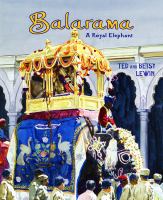
With exciting text and lush, photo-realistic watercolors, the Lewins describe their close-up encounters with parade elephants in southern India in the late 1990s. After they meet a magnificent Royal Elephant, Drona, in the forest, they decide to return a year later to see the animal lead the city of Mysore's parade. Unfortunately, Drona dies before the Lewins' return, but they watch his successor, Balarama, lead the parade for the first time. Can he live up to his predecessor? The views of Balarama with his brightly painted head and shoulders are majestic, and so are the rest of the scenes of the big-city ceremony, featuring soldiers on horseback in front of the palace. Along with the glowing images of elephants in their shimmering silk drapes of purple and red, there are occasional, line-and-watercolor pictures of tourists in a nearby camp, watching a young, mischievous elephant chasing the local children. The combination of compelling travelogue and images is immediate and dramatic. Kids will also enjoy the extensive back matter, which includes elephant facts and a glossary.--Rochman, Hazel Copyright 2009 Booklist
Gr 3-6-The Lewins continue their accounts of their worldwide adventures, here with two voyages to southern India. On their first trip, they visited a camp of trained elephants and their handlers in the forest and learned of the royal elephants used for festivals. They met Drona, who was to lead the annual Dasara procession in Mysore in the fall, and they were so enraptured that they decided to return for the festival. Upon their arrival, they learned that Drona had died, and that a new elephant had been chosen to lead the procession. Ted Lewin's brilliant, realistic watercolors capture the sun-drenched pageantry of Mysore as well as the dusty, filtered light of the forest, while Betsy Lewin's lively cartoons aptly depict the action and personalities involved. The story has pathos and tension, and the Lewins' narration takes readers into the forest, to the grounds of the maharaja's pale palace, along the parade route, and eye-to-eye with the majestic animals. Facts about elephants and brief biographies of some of the royal elephants are a welcome addition, and a glossary-with pronunciation help-is provided. If the art doesn't grab chidren, the elephants surely will. Wonderful.-Paula Willey, Baltimore County Public Library, Towson, MD (c) Copyright 2010. Library Journals LLC, a wholly owned subsidiary of Media Source, Inc. No redistribution permitted.
Rich watercolors and as-it-happens writing bring the story of India's royal elephants into sharp focus. On the Lewins' (Gorilla Walk) first trip to India, they hear about Drona, a beloved elephant chosen to head the parade of a religious festival. When they meet Drona face-to-face, they agree: "He is magnificent. We feel his aura strongly." But between their first trip and their second, Drona is killed in an accident, and the focus shifts to Balarama, the newly chosen lead elephant. How will Balarama cope with the noise and the crowds? The Lewins' watercolor spreads emphasize India's brilliant light, deep purple shadows and the way the elephants dwarf their human handlers. They are honest about the cruelty of past capture methods, but include anecdotes to offset the story's sober moments (as when Drona tips over a truck carrying bananas "and ate all but one case"). Loose sketchbook spots appear intermittently, which will either provide light relief or distract from the more ambitious and realistic spreads. Still, for a clear view of a tradition dating back centuries, it's a valuable contribution. Ages 6-11. (Sept.) (c) Copyright PWxyz, LLC. All rights reserved


